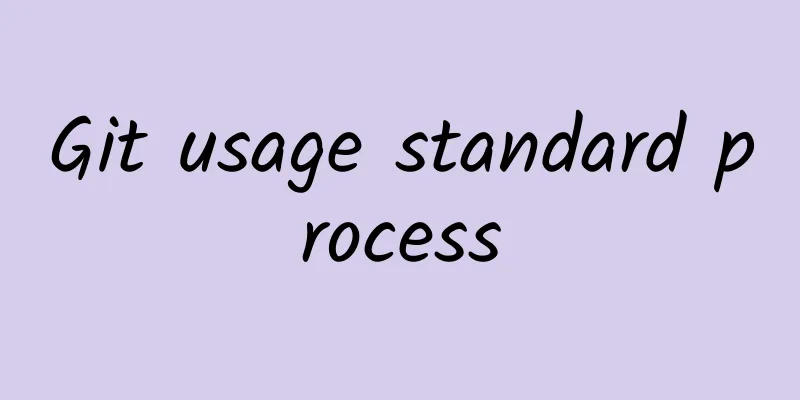Git usage standard process

|
In team development, it is very important to follow a reasonable and clear Git usage process. Otherwise, everyone submits a bunch of disorganized commits and the project quickly becomes difficult to coordinate and maintain. Below is ThoughtBot's standard Git usage process. I learned a lot from it and recommend you to use Git in the same way. Step 1: Create a new branch First of all, every time you develop a new feature, you should create a separate branch (for this, you can refer to "Git Branch Management Strategy").
Step 2: Submit the branch commit After the branch is modified, you can submit the commit.
The all parameter of the git add command means saving all changes (including new, modified, and deleted). Since Git 2.0, all is the default parameter of git add, so you can also use git add . instead. The git status command is used to view changed files. The verbose parameter of the git commit command will list the results of the diff. Step 3: Write your commit message When submitting a commit, you must give a complete and concise commit message. The following is a template.
The first line is a summary of no more than 50 words, followed by a blank line, listing the reason for the change, major changes, and issues that need attention. Finally, provide the corresponding URL (such as a bug ticket). Step 4: Synchronize with the mainline During the development of the branch, it is necessary to keep it synchronized with the trunk frequently.
Step 5: Merge commit After the branch development is completed, there may be a lot of commits, but when merging it into the trunk, you often hope that there is only one (or at most two or three) commits, which is not only clear but also easy to manage. So, how can we merge multiple commits? This requires the git rebase command.
The i parameter of the git rebase command stands for interactive. At this time, git will open an interactive interface to proceed to the next step. The following example uses Tute Costa to explain how to merge commits.
The interactive interface above first lists the 4 latest commits of the current branch (the lower the newer). There is an operation command in front of each commit, the default is pick, which means that the commit line is selected and the rebase operation is to be performed. Below the 4 commits are a bunch of comments listing the commands that can be used.
Among the above 6 commands, squash and fixup can be used to merge commits. First, change the verb in front of the commits to be merged to squash (or s).
After this change, there will only be two commits left in the current branch. The commits on the second and third lines will be merged into the commit on the first line. The commit information will contain the commit information of these three commits at the same time.
If the squash command in the third line is changed to the fixup command.
The running results are the same, and two commits will be generated. The commits on the second and third lines are merged into the commit on the first line. However, in the new commit information, the commit information on the third line will be commented out.
The squash and fixup commands can also be used as command line parameters to automatically merge commits.
Please refer to this article for its usage, which will not be explained here. Step 6: Push to remote repository After merging the commit, you can push the current branch to the remote repository.
The git push command needs to be added with the force parameter, because after rebasing, the branch history has changed and may not be compatible with the remote branch, so it may be necessary to force push (see here). Step 7: Issue a Pull Request After submitting to the remote repository, you can issue a Pull Request to the master branch, and then ask others to review the code and confirm that it can be merged into the master branch. |
>>: How to create a CocoaPods in Swift
Recommend
Tujia.com's big data precision marketing solution!
Tujia.com Big Data Precision Marketing Solution P...
Product operation: Let users share the deep logic of fission!
A good product will make users want to share, spo...
Identity cards that can be used for real-name authentication, a complete list of valid identity card numbers for real-name authentication for anti-addiction games in 2021!
2021 Latest Game Anti-addiction Real-name Authent...
Design your marketing landing page like this to make users buy in
The core of marketing is to guide and influence t...
The business methodology of live e-commerce
Judging from the monthly active user scale of sev...
10 secrets of Apple: Inside Apple's product design studio
If we were to add an adjective to Apple, there wo...
Customized birthday blessing video for foreign beauties
I believe everyone hopes to receive video birthda...
How to acquire a large number of accurate users at low cost?
In 2017, the operation method of increasing fans ...
Let’s talk about the three common mainstream promotion methods of Taobao customers
Today I want to talk to you about the common ways...
Segment "user activity status" to help you achieve KPI indicators
“Why has the conversion rate decreased? I can’t f...
How to motivate users and achieve user activity?
Someone once asserted that tool apps are doomed t...
Securities Qualification Examination Finance and Law
Securities Qualification Examination Finance and ...
5 steps to plan an event promotion!
Whether you are doing user operations, new media ...
High imitation Xiaomi Mall splash animation
Source code introduction This is a high imitation...
What are the Douyin store operation skills? Douyin store operation skills and practice
To open a store on the Douyin platform, you actua...









